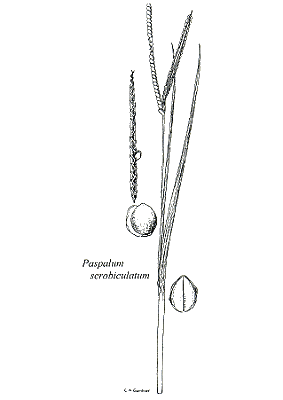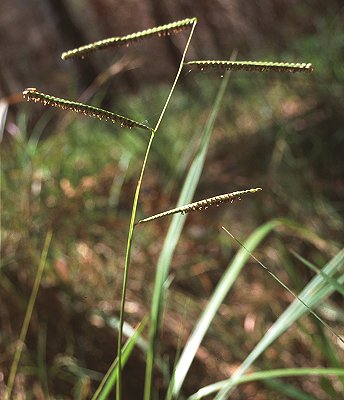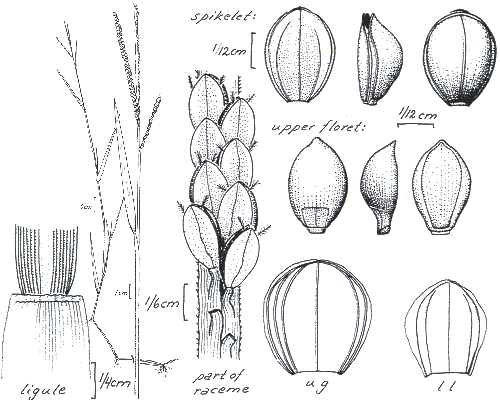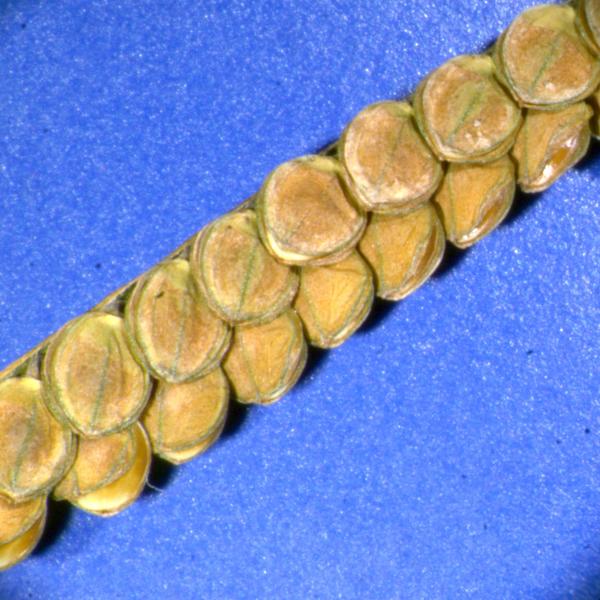Paspalum scrobiculatum L. Mant. Pl.
1: 29 (1767).
Classification. (GPWG 2001) : Subfamily
Panicoideae. Paniceae.
Type of Basionym or
Protologue Information: LT: Cultivated at Uppsala from material collected
in India (LINN-79.4; ILT: K). LT designated by ?.
Recent synonyms:
P. commersonii, P. orbiculare.
Key references
(books and floras): [1810]. R.Brown, Prodromus (188 as P.
orbiculare, P. pubescens), [1878] G.Bentham, Flora Australiensis 7
(460), [1952] C.A.Gardner, Flora of Western Australia 1 Gramineae
(242), [2002] D.Sharp & B.K.Simon, AusGrass, Grasses of Australia,
[2008] S.W.L.Jacobs, R.D.B.Walley & D.J.B.Wheeler, Grasses of New South
Wales (329 & 330 as P. orbiculare).
Illustrations:
[1952] C.A.Gardner, Flora of Western Australia 1 Gramineae (244,
Pl.72 as P. commersonii), [2008] S.W.L.Jacobs, R.D.B.Whalley &
D.J.B.Wheeler, Grasses of New South Wales, 4th edn (329 as P.
orbiculare & 330).
Habit.
Perennial. Rhizomes present. Stolons absent or present. Culms erect or
geniculately ascending or decumbent, 10–150 cm tall, 1–6 mm diam., 2–17 -noded.
Mid-culm nodes glabrous. Lateral branches sparsely branched. Leaf-sheaths
glabrous on surface. Leaf-sheath auricles absent, or present. Ligule an
eciliate membrane, 0.4–3 mm long. Leaf-blades 5–40 cm long, 3–15 mm wide.
Leaf-blade surface smooth, glabrous.
Inflorescence.
Inflorescence compound, a panicle of racemes. Racemes 1–20, spreading, 2–15 cm
long, 1.7–2.5 mm wide, bearing 30–110 fertile spikelets on each. Central
inflorescence axis 0–8 cm long.
Spikelets.
Spikelets pedicelled. Fertile spikelets 2-flowered, the lower floret barren
(rarely male), the upper fertile, comprising 1 basal sterile florets,
comprising 1 fertile floret(s), without rachilla extension, obovate or
orbicular, dorsally compressed, 1.4–3 mm long.
Glumes. Glumes
thinner than fertile lemma. Upper glume elliptic, 2.1–2.9 mm long, hyaline or
membranous or chartaceous, without keels, 5–7 -nerved. Upper glume surface glabrous.
Florets. Basal sterile florets 1, barren, without significant palea.
Lemma of lower sterile floret 100 % of length of spikelet, chartaceous, 3–5
-nerved.
Fertile lemma 2.1–2.9
mm long, without keel, 5 -nerved.
Continental
Distribution: Africa, Temperate Asia, Tropical Asia, Australasia, Pacific,
and South America.
Australian
Distribution: Western Australia, Northern Territory, Queensland, New South
Wales, Norfolk I.
Western Australia:
Gardner. Northern Territory: Darwin & Gulf, Victoria River, Barkly Tableland.
Queensland: Burke, Cook, Darling Downs, Leichhardt, Moreton, North
Kennedy, Port Curtis, South Kennedy, Wide Bay. New South Wales: North
Coast, Central Coast, South Coast.
Notes. This
widespread, morphologically variable species is similar to the endemic P.
longifolium. Whether the spikelets occur singly or in pairs can usually
separate the two; however, occasionally paired spikelets occur in P.
scrobiculatum. Typically, the spikelets of P. longifolium are yellow
with scattered hairs on the upper glume and lower lemma, whereas those of P.
scrobiculatum are light green and glabrous. The P. scrobiculatum
complex is notoriously difficult to treat taxonomically as it is possibly an
aggregate swarm of apomicts. The approach of Clayton (1975) is the one followed
here. Another approach is that of De Koning and Sosef (1985), where, as well as
the separation of P. orbiculare Forst.f., the species P.
scrobiculatum has been divided into 5 varieties. If this revision is
followed the variety occurring in Australia is P. scrobiculatum var. bispicatum
Hackel ( = P. commersonii Lam.).
In tropical and
subtropical rain forests, dry sclerophyll forests, tropical and subtropical
sub-humid woodlands, and coastal grasslands. Usually associated with damp soils
and grazed in moderation. Flowers mostly Dec.-June.






